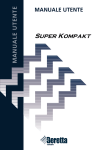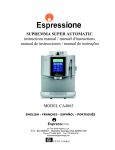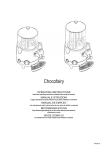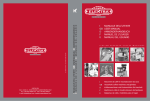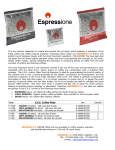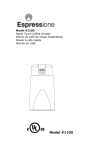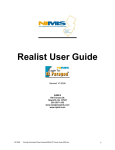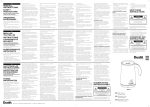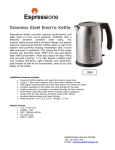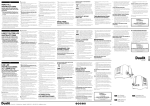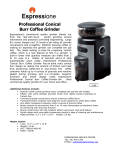Download Espressione 1334/1 Use and Care Manual
Transcript
MOD. 1334 - 1334/1 COD. 4025107000 REV. 0 del 19/05/2009 c/o The Smith Agency, Ltd. P.O. Box 669307 Marietta, Georgia USA 30066.0106 Phone 770.509.3006 Fax 770.509.8736 [email protected] 827070 After Sales Service Electra Craft 41 Woodbine Street Bergenfield, NJ 07621 201 439 1700 [email protected] A W U B C Q N V M U L T S D K Fig. 13 Fig. 14 Fig. 15 Fig. 16 Fig. 17 Fig. 18 Fig. 19 Fig. 20 R E Q J F G Fig. 12 P H I O Fig. 1 Fig. 2 Fig. 3 Fig. 6 Fig. 9 Fig. 4 Fig. 5 Fig. 7 Fig. 8 Fig. 21 Fig. 22 Fig. 23 Fig. 10 Fig. 11 Fig. 24 Fig. 25 Fig. 26 Even if the appliances are made in conformity with the European regulatory specifications in force and therefore all potentially hazardous parts are protected. Carefully read these warnings and use the appliance only for the use it is designed for in order to prevent accidents and damage. Keep this manual close by for future consultation. If you should decide to give this appliance to other people, remember to also include these instructions. The information provided in this manual is marked with the following symbols indicating: Danger for children Warning of burns Danger due to electricity Warning – material damage Danger of damage originating from other causes INTENDED USE You may use your Caffè Minuetto to prepare coffee and cappuccinos. This appliance is designed only for private use, and is therefore to be considered unsuitable for commercial or industrial purposes. No other use of the machine is contemplated by the manufacturer, which is exempt from any liability for all types of damages caused by improper use of the machine. Improper use also results in any form of warranty being forfeited. RESIDUAL RISKS The construction characteristics of the appliance this publication refers to do not allow the user to be protected from a direct jet of steam or hot water. Warning! Danger of burns – When dispensing hot water and steam, do not direct the jets towards others or yourself. Hold only the plastic part of the tube. Use only containers made of material “for foods”. IMPORTANT SAFEGUARDS READ THE INSTRUCTIONS CAREFULLY BEFORE USE. •This appliance is designed only for private use, and is therefore to be considered unsuitable for commercial or industrial purposes. •We decline any responsibility resulting from misuse or any use other than those covered in this booklet. •We suggest you keep the original box, as our free-of-charge service does not cover transportation damage due to inadequate packaging of the product when sent to an Authorised Service Centre. •Do not use appliance for other than intended use. Danger for children •This appliance is not suitable for use by people (children included) with physical, sensorial or mental disabilities. Users lacking experience and knowledge of the appliance, or those who have not been given the user’s instructions, must be supervised by a person responsible for their safety. •Children must be supervised at all times to ensure they do not play with the appliance. •Do not leave the packing components near children because they are potentially dangerous. •In the event that this appliance is to be disposed of, it is recommended that the power chord be cut. It is also recommended that all potentially dangerous compo3 English WITH REGARD TO THIS MANUAL English nents are rendered harmless to prevent children from hurting themselves when playing with the apparatus. •Do not leave the cleaning pin within reach of children and put it in a safe place: danger of swallowing and injury. Danger due to electricity •Before connecting the appliance to the power supply, make sure that the voltage indicated on the plate on the bottom of the machine corresponds to the local mains voltage. •This appliance has a polarized plug (one blade is wider than the other). To reduce the risk of electric shock, this plug is intended to fit into a polarized outlet only one way.If the plug does not fit fully into the outlet, revers the plug. If it still does not fit, contact a qualified electrician. Do not attempt to modify the plug in any way. •The use of extension leads, which have not been authorised by the appliance manufacturer, may cause damage and accidents. •Before filling the tank with water, remember to always disconnect the appliance at the socket. •If the electric cable is damaged it must be replaced by the manufacturer or its Technical Assistance Service, or in any case by a person with similar qualifications. •Never let the live parts come into contact with water: this may cause a short circuit! •Unplug before any cleaning or maintenance operations. •DO NOT IMMERSE THE APPLIANCE IN WATER OR OTHER LIQUIDS. •Unplug the appliance from the electricity supply immediately in the case of faults, defects or suspected defects after dropping. Never operate the appliance if defective. REPAIRS MAY ONLY BE CARRIED OUT BY AUTHORIZED ASSISTANCE SERVICE CENTRES. The manufacturer disclaims all responsibility for any damage caused by incorrect repair work. Danger of damage originating from other causes •To reduce the risk of injury, do not drape cord over the counter top or table top where it can be pulled on by children or tripped over unintentionally. •Always attach plug to appliance first, then plug cord into the wall outlet. •Do not lift the appliance by grasping its water tank, but only by grasping its body. •Choose a sufficiently well lit and clean environment, with an easily accessible electric socket. •Avoid putting excessive quantities of water into the tank. •The appliance is not to be used if it has been dropped, if there are visible sign of damage or if it is leaking. To prevent any accident, all repairs, including the replacement of the power cord, must be carried out by an Authorised Service Centre or, in any case, by qualified personnel. •Do not use the appliance if the power cord appears to be damaged, with parts showing burns, etc.; an authorised Espressione service centre must repair and replace the power cable, under penalty of the warranty being forfeited. 4 Warning – material damage •Do not let cord hang over edge of table or counter, or touch hot surfaces •The use of accessory attachments not recommended by the appliance manufacturer may result in fire, electric shock or injury to persons. •Place the machine on a stable surface where it cannot be knocked over. •Never use the machine without water because the pump will burn out. •Never fill the water tank with hot or boiling water. •Do not place the machine on very hot surfaces or near open flames in order to prevent damage to the body. •The cable must not touch any hot parts of the machine. •Do not use sparkling water (with added carbon dioxide). •Never put substances other than ground coffee into the filter holder. They could cause serious damage to the appliance. •Do not leave the machine at a room temperature below 32°F (0°C) because the water remaining in the boiler could freeze and cause damage. •Never use the appliance outdoors. •Do not expose the appliance to atmospheric agents (rain, sun …). •Before cleaning the appliance always unplug it and allow it cool down. Clean only with a non-abrasive cloth that has been slightly dampened with water, adding a few drops of mild, non-aggressive detergent (never use solvents that damage plastic). • KEEP THESE INSTRUCTIONS IN A SAFE PLACE 5 English Warning of burns •Do not touch hot surfaces. Use handles or knobs. •Never direct the steam or hot water jet towards parts of the body; handle the steam spout with care: risk of scalding! •The appliance’s external metallic parts must not be touched when the machine is functioning as it could cause burns. •If water does not come out of the filter holder, it may be because the filter is clogged. In this case slowly remove and disconnect the filter holder because any remaining pressure could cause splashes or squirts. Then clean as explained in the relevant paragraph. English DESCRIPTION OF THE APPLIANCE A - Tank cover B - Removable water tank C - Machine body D - On indicator lamp E - Power supply cable F - On-off switch G - Float support H - Full drip tray indicator I - Removable drip tray J - Removable cup grill K - Steam pipe L - Coffee or steam dispensing knob “STANDBY”: machine in standby Identification data : coffee dispensing : steam dispensino M - Boiler temperature indicator lamp N - Grill O - Drip tray disk locking screw P - Filter holder lock Q - Filter holder R - Drip tray disk S - 1-cup coffee filter T - 2-cup coffee filter U - Pod filter V - Pod filter W- Cleaning pin The following machine identification data are shown on the plate found underneath the machine’s standing base: • manufacturer and CE mark • model (Mod.) • serial number (SN) • electrical supply voltage (V) and frequency (Hz) • absorbed electric power (W) • assistance toll-free number Always give the model and serial number to the Authorised Service Centres when requesting assistance. Preliminary phases for use Starting the appliance Check that the voltage of the domestic network is the same as that indicated on the technical information plate of the appliance. Place the appliance on a flat surface. Wash the tank (B) the first time it is used and fill it with cool tap water (Fig. 3) up to the level marked “MAX”, then being careful to put it back into its seat securely (Fig. 4). Check that the tank is properly inserted; otherwise, the machine may not dispense coffee. Insert the plug into the socket, which must be earthed. Starting the first time After having filled the tank up with cool tap water, start the machine by pressing the button (F) Fig 5. The indicator lamp (D) will turn on, indicating that the machine is on, as well as indicator lamp (M), indicating that the internal boiler is starting to heat up. Placed a container underneath the filter holder connection flange and turn the knob (L) to the coffee position ( ) until you see water coming out of the filter holder seat (Fig. 6). HOW TO MAKE COFFEE Select the desired filter (S) for 1 cup, or (T) for 2 cups, and put it into the filter holder (Fig. 7). Measure out the coffee in the filter and lightly press with the specially provided presser (Fig. 8). Completely fill two measures for two cups of coffee, and fill only one for one cup. Insert the filter holder into its seat (Fig. 9). Tighten well by turning it from left to right while making sure you have hooked it properly onto the flange (Fig. 10). Warning! If too much ground coffee is put inside the filter, turning the filter holder may prove difficult and/or you may get leaks from the filter holder when the coffee is being dispensed. To get the first cup of coffee piping hot, too, it is advisable to let the filter holder heat up a few minutes in its seat before making the coffee. This will not be necessary for the cups of coffee that follow. Place one or two cups under the filter holder spouts (Fig. 11-12) and start dispensing by turning the knob (L) to the coffee position ( ). The coffee will start coming out of the spouts of the filter holder. To stop it, put the knob back in the central standby position. The maximum dose for one cup of espresso is 1½ ounces/50 ml. Warning! Like in professional coffee machines, do not remove the filter holder during dispensing; danger of burns! 6 Filling the water tank during use Be sure to fill the tank before the water is completely used up. Turn off the machine, unplug it from the socket-outlet and fill the tank up to the level marked “MAX” with cool tap water. Put the tank on the machine, making sure it is inserted securely, and turn it back on. If the tank is left completely dry, air may enter the circuit, preventing coffee from being dispensed. It is therefore necessary to turn the machine off and let it cool down in order to put it back in service. Place a container underneath the filter holder coupling seat and turn on the machine by immediately turning the knob (L) to the position ( ). Make at least one cup of water come out of the filter holder coupling seat to put the hydraulic circuit back in service. Stop dispensing by putting the knob (L) back in the central “STANDBY” position. At this point the machine will start to work regularly again. HOW TO MAKE COFFEE WITH A POD Put the pod filter (U) inside the filter holder (Q). 1Place the pod in the filter ring (Fig. 14). 2Push the pod towards the bottom of the filter with your fingers (Fig. 15). 3The pod must be well centred and placed inside the filter. 4Now it is possible to put the filter holder in its seat. Tighten the filter holder while making sure you have hooked it properly onto the flange (Fig. 10). 5The pod could remain stuck in the upper part of the machine after making the coffee and when removing filter holder. To remove it, tilt the filter holder (Fig. 16) so the pod can fall onto it. In order to always get an excellent cup of coffee, buy the pod that bears the E.S.E. compatibility mark. If the pod is not inserted well, or if the filter holder is not tightened firmly, a few drops of water could leak from the filter holder. HOW TO MAKE CAPPUCCINO Wait for the indicator lamp (M) to turn off. It indicates that the boiler has reached the right temperature for dispensing steam. Warning! When warming up, your appliance may release small puffs of steam from the filter holder; this is perfectly normal. Turn the knob (L) to the steam dispensing position ( ) after placing a glass underneath the steam pipe (K), Fig. 18. First some water will come out, followed immediately by a jet of steam whose intensity will increase within a few seconds. Put the knob (L) back in the “STANDBY” position and place the pot of milk to be whipped under the froth accessory. Plunge the wand all the way into the pot of milk (Fig. 19) and again turn the dispensing knob (L) progressively on the steam position ( ) until you get the result you want. During these operations you may notice that the warning light (M) goes on and off from time to time, indicating that the boiler thermostat is keeping the water required for the steam supply at the right temperature. Put the knob (L) back on “STANDBY” to stop dispensing steam. Dispense the steam for a few seconds after every use to free the hole of any milk residue and clean the steam pipe with a sponge. USEFUL TIPS FOR OBTAINING A GOOD ITALIAN ESPRESSO The ground coffee in the filter holder has to be pressed lightly. Whether the coffee is stronger or weaker depends on the degree the coffee is ground, the quantity put into the filter holder and the pressing. Just a few seconds are needed for the coffee to flow down into the cups. If the dispensing time is longer, this means that the coffee is ground too fine or that the coffee put into the filter holder has been pressed too much. 7 English Warning! Wait about ten seconds after the coffee has been dispensed before removing the filter holder. To remove it, turn it slowly from right to left so as to prevent splashes or spurts of water or coffee. To remove the coffee residue from the filter, press the filter lock (P) forward over the edge of the filter, turn the filter holder over and shake it gently (Fig. 13). When the machine is in stand-by, the lamp (M) will turn on and off periodically. This shows that the boiler thermostat is tripping, which serves to keep the water temperature optimum. It is a good idea to start dispensing the coffee only when this indicator lamp is off, and this is true for both the first cup and those that follow. English CLEANING THE APPLIANCE Warning! All cleaning operations described below must be performed with the machine off and with the electric plug disconnected from the socket-outlet. Warning! Regular maintenance and cleaning preserve and keep the machine efficient for a longer amount of time. Never wash machine components in the dishwasher. Do not use direct jets of water. Warning! All operations must be performed when the machine is cold. Cleaning the filter containing the grounds Check that the coffee exit hole is not clogged and if so, clean it with the pin provided (Fig. 20). Warning! Handle the pin provided with care when cleaning the appliance: danger of injury. Dispense boiling water from the filter holder with the filter inside, without coffee grounds, in order to dissolve or remove any coffee residue or impurities. It is advisable to thoroughly clean the filter (S) or (T) about every 3 months using dishwasher detergent tab (without added rinse aid or other chemical additives) as follows: • Put a dishwasher detergent tab into the filter (without coffee) when the machine is hot (after heating for at least five minutes). • Couple the filter holder to the machine and put a container underneath the filter holder. • Turn the knob (L) to the coffee position ( ) to start dispensing water and dispense water for 15-20 seconds. • Stop the water supply and let the tab act for at least 15 minutes while keeping the filter holder coupled on the machine. • Repeat the water dispensing operation by operating the pump for about 15-20 seconds, and then letting it rest for another 15-20 seconds, until two tanks of water are used up. • Remove the filter holder from the machine, remove the filter and rinse it well under running tap water. • Turn off the machine, disconnect the power cable from the socket-outlet and clean the coupling seat of the filter holder with a sponge in order to remove any detergent residue from the shower disc. • Turn the machine back on, couple the filter holder once again and dispense at least 2 cups of water again to complete the rinsing. If the coffee machine is used daily, it is advisable to carry out the cleaning operation at least every three months. Cleaning the filter holder seat With time, coffee residue may accumulate on the filter holder seat. It can be removed with a toothpick, a sponge (Fig. 21), or by letting water run through without fitting the filter holder (Fig. 6). Cleaning the steam nozzle Warning! Perform this operation when the chrome-plated pipe is cold so as to prevent burns. Remove the steam pipe (K) Fig. 22 and wash it under running water. The nozzle can be cleaned with a non-abrasive cloth. Slip the steam pipe on and push it as far as it will go. If necessary, clean the steam exit hole with the pin (W) provided (Fig. 23). After use, always let the steam nozzle run for a few seconds so to free the outlet from any possible residue. Cleaning the tank Periodically clean the inside of the tank with a sponge or damp cloth. Cleaning the grill and drip tray Remember to empty the drip tray from time to time (I). Remove the drip tray (I) from the machine (Fig. 24-25-26), empty it and wash it under running water. Wash the grill (J) under running water. Cleaning the machine body Warning! Clean the fixed parts of the machine using only a damp, non-abrasive cloth so as to not damage the body. DECALCIFICATION Good maintenance and regular cleaning preserve and keep the machine efficient for a longer amount of time, considerably limiting the risks of lime deposits forming inside the appliance. However, should your coffee machine fail to work properly as a result of the frequent use of hard, high calcium content water, you may perform a decalcification procedure to restore its operational efficiency. For this purpose you must use only citric acid-based decalcifying products. This product is easily 8 PUTTING OUT OF SERVICE If you want to put the machine out of service, you must disconnect it electrically, empty the water tank and drip tray and clean it (see the paragraph on “Cleaning the appliance”). In the case of scrapping, you must separate the various materials used in making the machine and dispose of them based on their composition and on the legal provisions in force in the country of use. TROUBLESHOOTING If there are problems with operation, immediately turn off the machine and unplug it from the socket-outlet. PROBLEM The coffee maker does not supply steam. CAUSE There is little water and the pump does not suck it up. Steam exit hole is clogged. SOLUTIONS Check that the water level in the tank is correct. If necessary, fill it with cool tap water up to the level marked “MAX”. Unclog any deposits that may have formed in the holes of the froth accessory with the pin provided. Remove the filter holder and clean the coupling seat with a sponge (Fig. 21). Repeat the operation placing the correct quantity of coffee in the filter. Coffee overflowing from the edges of the filter ring. The coffee is not supplied or flows too slowly. Probably an excess amount of ground coffee has been placed in the filter ring preventing the filter ring from being correctly tightened into its housing. Residues of ground coffee have Clean the seal with a toothpick or a sponge (Fig. 21). remained on the gasket of the filter holder coupling seat. The exit hole of the filter contain- Slowly remove and disconnect the filter holder because any ing coffee grounds is clogged. remaining pressure could cause splashes or squirts. Clean the clogged filter hole using the pin provided. Clean the clogged filter hole with a small brush or a pin. Faulty pod. Slowly remove and disconnect the filter holder because any remaining pressure could cause splashes or squirts. Clean the coupling seat with a sponge (Fig. 21). Replace the pod in the filter holder. The holes of the perforated disc Turn on the machine without the filter holder, making the water in the filter holder coupling seat run. If the water still does not come out from all the holes are clogged. evenly, carry out the descaling cleaning operation. The coffee is too watery and cold. The exit hole of the filter contain- Slowly remove and disconnect the filter holder because any ing coffee grounds is clogged. remaining pressure could cause splashes or squirts. Clean the clogged filter hole using the pin provided. The coffee blend is ground too Try using coarser coffee blends. fine. The coffee blend is pressed Tamper coffee inside the filter using less pressure. down too much. The tanks is not inserted well. Fit the tank securely by pushing it as far as it will go. There is little water and the pump Make sure the tank is properly inserted and check that the does not suck it up. water level in the tank is correct. Fill with cool tap water up to the level marked “MAX”. Faulty pod. Slowly remove and disconnect the filter holder because any remaining pressure could cause splashes or squirts. Clean the coupling seat with a sponge (Fig. 21). Replace the pod in the filter holder. Broken pod. Slowly remove and disconnect the filter holder because any remaining pressure could cause splashes or squirts. Clean the coupling seat with a sponge (Fig. 21). Replace the pod in the filter holder. The blend has been ground too A more finely ground blend must be used to obtain a more coarsely. concentrated and hotter coffee. 9 English found at the Espressione technical service centres. Espressione does not assume any responsibility whatsoever for damage to components inside the coffee machine caused by the use of non-compliant products containing chemical additives. Should you need to decalcify your appliance, please follow the instructions which come with the decalcifying product.










